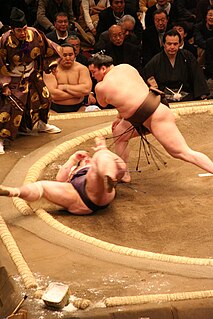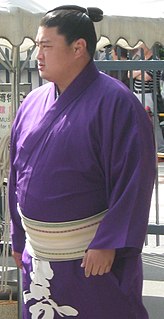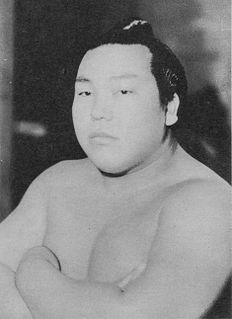
Makuuchi (幕内), or makunouchi (幕の内), is the top division of the six divisions of professional sumo. Its size is fixed at 42 wrestlers (rikishi), ordered into five ranks according to their ability as defined by their performance in previous tournaments.

Kisenosato Yutaka born July 3, 1986, as Yutaka Hagiwara is a Japanese former professional sumo wrestler from Ibaraki. He made his professional debut in 2002, and reached the top makuuchi division in 2004 at the age of just 18. After many years in the junior san'yaku ranks, he reached the second highest rank of ōzeki in January 2012. He earned three kinboshi or gold stars by defeating yokozuna in his career leading up to ōzeki and nine special prizes. He scored more than 20 double-digit winning records at the ōzeki rank. In 2016, he secured the most wins in the calendar year, the first wrestler to do so without winning a tournament in that year.

Toyonoshima Daiki is a former professional sumo wrestler from Sukumo, Kōchi, Japan. He made his professional debut in January 2002, reaching the top makuuchi division in September 2004. He was a runner-up in five tournaments, and earned ten special prizes. His highest rank was sekiwake, which he first reached in September 2008 and held for five tournaments in total. Following a suspension in July 2010 he was demoted to the jūryō division, but upon his return to makuuchi in November 2010 he took part in a playoff for the championship. He won four kinboshi or gold stars awarded for yokozuna upsets, three of them earned by defeating Harumafuji from 2013 to 2015. He wrestled for Tokitsukaze stable. He retired in 2020 and is now an elder of the Japan Sumo Association under the name of Izutsu Oyakata.

Yoshikaze Masatsugu is a former sumo wrestler from Saiki, Oita Prefecture, Japan. His highest rank was sekiwake. A former amateur sumo champion, he turned professional in 2004, reaching the top division two years later. Until his promotion to komusubi in May 2014 he had the active record for the longest serving makuuchi wrestler who had never reached a titled rank. His best performance in a tournament came in July 2015 when he was the runner-up and scored twelve wins against three losses. In the following tournament in September 2015 he defeated two yokozuna and won special prizes for Outstanding Performance and Technique. Yoshikaze is in second place for the slowest promotion from makuuchi debut to the third highest sekiwake rank in history, behind only his stablemate Takekaze. He won ten special prizes in total, and eight gold stars for defeating yokozuna. He retired in September 2019 and is now an elder of the Japan Sumo Association, known as Nakamura Oyakata.
Kongō Masahiro was a former sumo wrestler from Hokkaidō, Japan. His highest rank was sekiwake and he won a top division tournament championship in 1975. He was a sumo coach and head of the Nishonoseki stable from 1976 until 2013.
The following are the events in professional sumo during 2009.
The following are the events in professional sumo during 2006.
The following are the events in professional sumo during 2004.
The following are the events in professional sumo during 2003.
The following are the events in professional sumo during 2000.
The following are the events in professional sumo in 1998.
The following are the events in professional sumo during 1995.
The following are the events in professional sumo during 1994.
The following are the events in professional sumo during 2012.
Tomojiro Toda, known as Haguroiwa Tomomi, was a sumo wrestler from Nobeoka, Miyazaki, Japan. He made his professional debut in May 1961, and reached the top division in January 1967. His highest rank was komusubi. He withdrew from active competition in January 1978 and remained in the Japan Sumo Association as an elder under the name Ikazuchi. He reached the mandatory retirement age of 65, and left the Sumo Association in June 2011.

Saganohana Katsumi was a professional sumo wrestler born as Katsumi Kitamura in Saga City, Japan. His highest rank was ōzeki.
The following were the events in professional sumo during 2016.

Shōdai Naoya is a Japanese professional sumo wrestler from Uto, Kumamoto. He is in the Tokitsukaze stable. He is a right hand inside-type wrestler. His highest rank is ōzeki. He has one gold star for defeating a yokozuna and seven special prizes, six for Fighting Spirit and one for Outstanding Performance. He was runner-up in two tournaments before winning his first top-division championship in September 2020.
The following are the events in professional sumo during 1992.

Wakasegawa Taiji was a sumo wrestler from Amagasaki, Hyōgo Prefecture, Japan. He made his professional debut in 1935, reaching the top makuuchi division in 1942. His highest rank was komusubi. He was twice runner-up in a tournament and earned seven gold stars for defeating yokozuna and four special prizes. He retired in 1959 at the age of 38 and became an elder of the Japan Sumo Association, working as a coach at Isegahama stable until his mandatory retirement in 1985.







